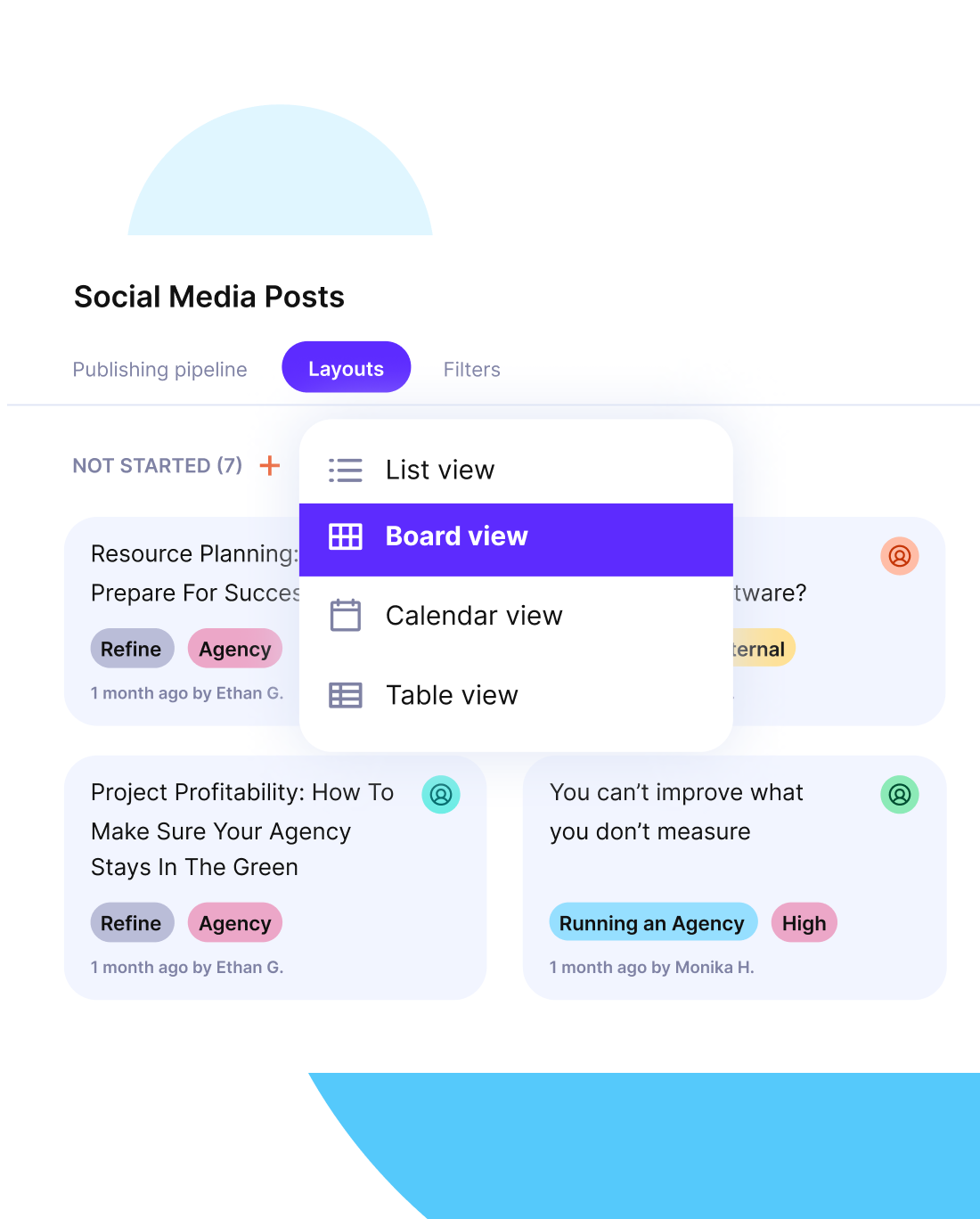What is Client Management + How To Improve It? (2026 Guide)
Many companies struggle to manage clients.
It usually looks something like: Slack for updates, spreadsheets for budgets, and email for feedback. It works at first, but the cracks show once you’re managing multiple clients at once.
This guide explains what client management means today, where it tends to break down, and how to fix it with clear processes and better tools.
Key Takeaways
- Client management is a process, not a personality trait; it’s how you set expectations, share updates, and keep your client project management aligned with broader goals.
- Common customer management problems include over-communication without clarity, mismanaged feedback, and relying on tools instead of systems.
- You can improve client management by standardizing client onboarding, centralizing feedback, automating updates, and planning capacity with data.
- The right client management tools make it easier to deliver a consistent, transparent experience without duplicating effort or relying on manual updates.
What Is Client Management?
Client management is the process people follow to build, maintain, and grow relationships with clients (or retainers) throughout every phase of a project.
Client lifecycle management pulls together communication, project tracking, budgets, and relationship-building into one clear process that helps both your team and your clients stay aligned.
This might include capturing task comments in one activity feed, setting up critical tasks with clear deadlines, or using task attachments to reduce back-and-forth.
Managing clients means a lot more than replying to emails or phone calls. We talk more about the core principles of client management and all forms of client communications later.
For now, keep in mind that managing clients is about:
- Setting clear expectations from the start.
- Giving clients visibility into progress and budget.
- Managing feedback and approvals in one place.
- Ensuring every customer touchpoint builds trust and reduces risk.
Done right, client management helps people keep projects on track, your scope stable, and your team focused on delivering work, not fixing communication breakdowns. In case you’d like a best practices overview, you might want to check out our client communication guide.
Why Is Client Relationship Management so Important?
Client relationship management is more important than ever because companies are working with a more demanding client base, across more channels, with less margin for error.
When internal processes lag behind this reality, client trust and project success both suffer. Then come higher churn rates, more stress and less profit.
Basically, the way clients work with agencies or professional client service providers has changed a lot. In 2026, transparency isn’t optional, responsiveness is expected, and trust is built (or lost) through how clearly you communicate and manage clients.
Your work could be a spot-on masterpiece, but if the process feels messy or unpredictable, you risk losing the client (and more potential customers).
Agencies today face:
- Shorter client attention spans
- Higher expectations for visibility
- More distributed teams
All of these might sound scary, but it’s normal in the professional service industry. Even high-performing teams struggle if they rely on gut feel or scattered tools to keep clients happy.
Since clients are key stakeholders, keeping them informed and engaged is essential to building trust and long-term success.
It’s Not Just About Retention, It’s About Efficiency
Strong client management helps you eliminate inefficiencies and give your team back valuable time (aka billable hours) each week. Instead of holding meetings just to align on status updates, your team can work from shared dashboards or progress reports.
Misaligned feedback, which often leads to unnecessary revisions, gets replaced with structured review cycles that everyone understands. And when responsibilities are clearly documented, there’s no second-guessing about who owns what or what’s due next.
The result is a better quality of interaction with fewer delays, less frustration, and a smoother experience for both your team and your clients. In other (obvious) words: healthy customer relationships are fuel for business growth.
What Are the Best Practices for Managing Clients?
The best practices in client management include standardizing onboarding, creating clear communication plans, aligning expectations, building feedback loops, and managing client access.
These practices help agencies reduce churn, increase client satisfaction, and create a more focused and predictable delivery process. Here’s how you should put them into action.
Manage clients and projects with Productive
1. Create a Central Source of Truth
Clients don’t want to ask three different people for status updates. Give them a central place to check what’s going on. This central place comes with modern project management software or CRM tools (more on those later).
These tools have helpful features like:
- Dashboards that show task progress, budgets, and timelines.
- Assigning ownership of deliverables and who’s responsible for what on both the company and client side.
- Custom fields to highlight important client information across tasks or projects.
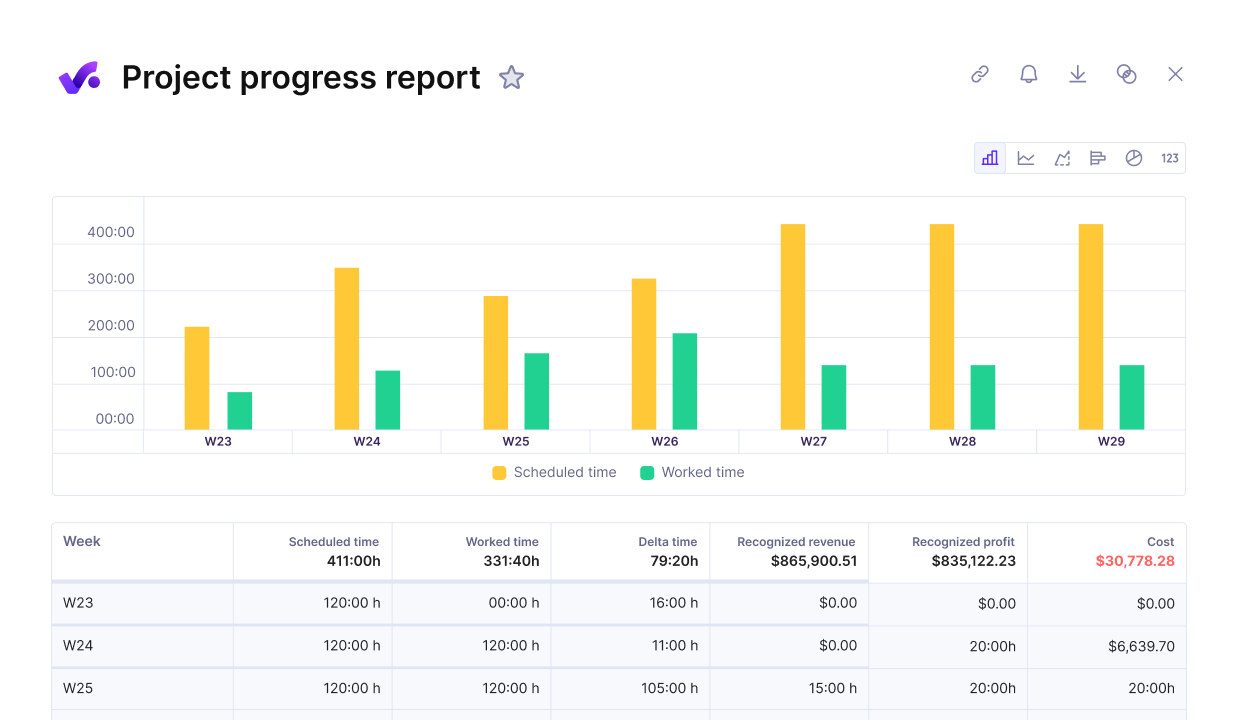
Report your client on project progress and the time spent in one view.
2. Keep Feedback Cycles Structured
Clients often give feedback late because no one told them when or how to share it. That leads to revisions, missed deadlines, and unhappy teams.
The best advice to maintain a regular and structured feedback cycle is to:
- Define feedback checkpoints at the start of every project.
- Include response windows and sign-off steps.
- Track who approved what and when, and make comments actionable by tying them to relevant tasks.
3. Set Expectations at Every Stage
Bad surprises (like delivering late due to whatever or whoever) kill trust. Be clear about what clients can expect at each stage, and what you need from your team to deliver on time.
Here’s how you can set clear expectations:
- Share timelines and communication cadences during onboarding.
- Let them know what happens if they miss a sign-off.
- Explain what’s in scope and what isn’t before the execution phase.
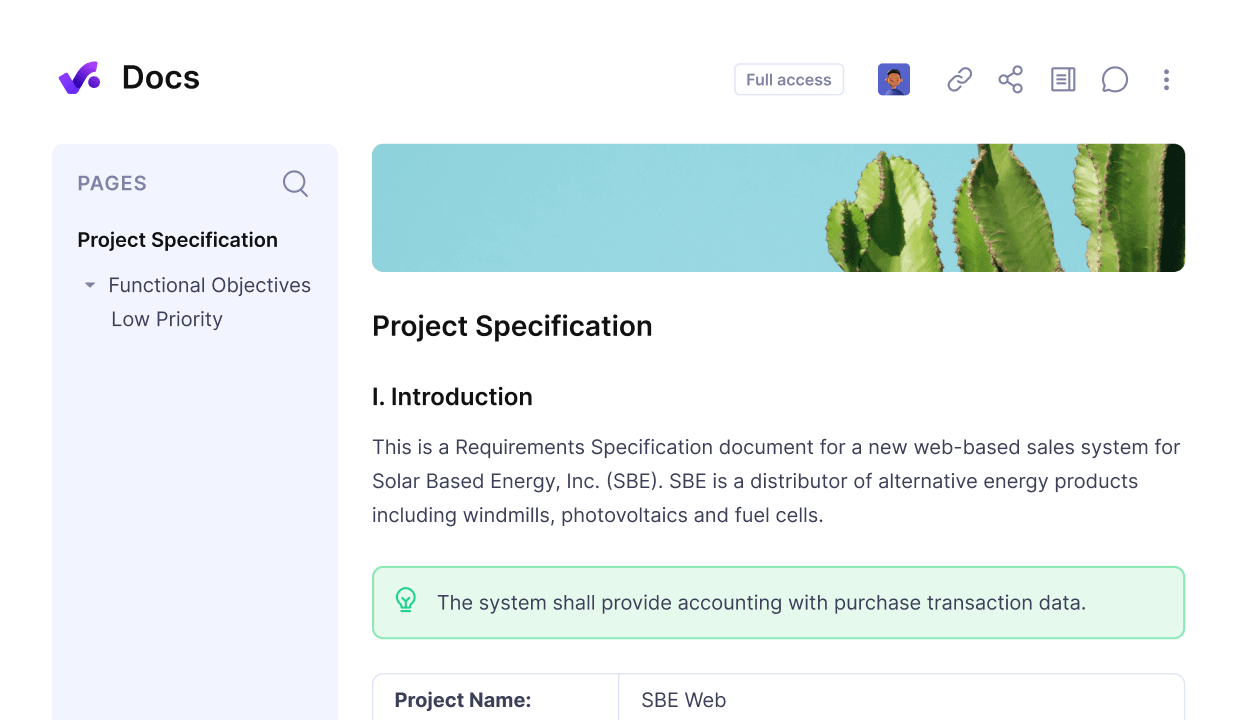
Make onboarding docs with mapped out communication and management protocols, and share them with your clients.
4. Plan Around Actual Team Capacity
Scope creep tends to happen when teams lack visibility into who’s available, which leads to unclear ownership, overbooking, and stressed-out delivery teams.
Here’s what you can do to implement this best practice:
- Use capacity data when estimating new work.
- Include buffers for complex projects or unknowns.
- Let clients know when you’re at capacity and why.
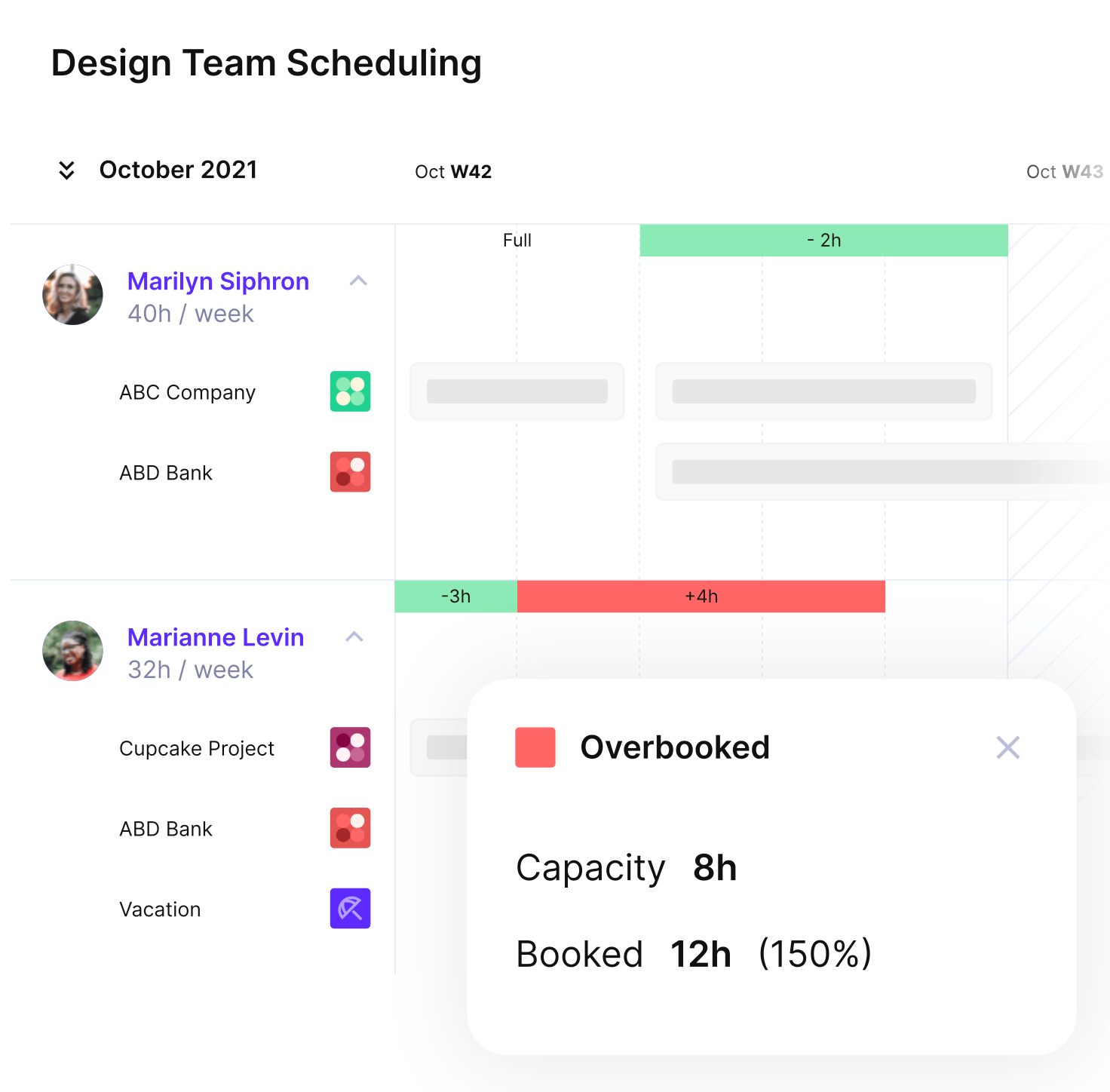
Use Productive to get a quick view of your team’s availability, utilization, and actual capacity.
If you’re having problems with figuring out your actual capacity or staff utilization, there’s a quick fix called capacity planning software.
5. Use the Right Level of Visibility
You don’t need to give clients access to everything, just the important and project-specific activities. They don’t need to send Slack messages or emails for basic updates.
Here’s how to do it:
- Choose tools with client-facing views or limited-access dashboards.
- Consider giving a guest user access to projects where it makes sense.
- Keep communication in one place and stick to a schedule.
- Send a short summary even when there’s “nothing new” to report.
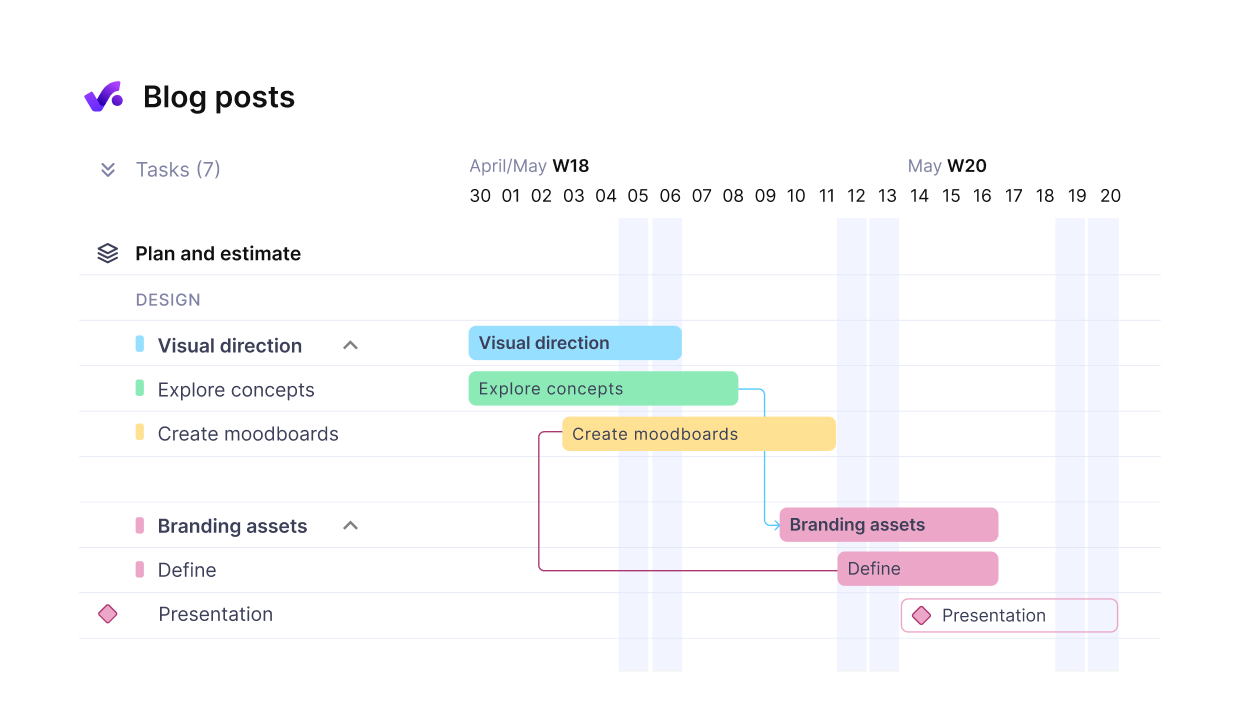
Invite clients to Productive for free and collaborate with them ontasks, free of charge.
What Are the Most Common Challenges in Managing Clients and How to Solve Them?
The most common challenges in managing clients include disconnected communication channels, unclear feedback, misaligned expectations, manual reporting, managing client contracts and lack of visibility into team capacity.
These issues often do not come from a lack of effort, but from trying to juggle too many tools and processes at once without a clear system. Even experienced teams fall into reactive patterns like responding to emails, chasing approvals, or jumping into unplanned calls, while losing sight of the bigger picture.
Below, we’ll take a closer look at these common challenges companies face when managing clients, along with practical and actionable solutions.
1. Disconnected Communication Channels
When updates are scattered across Slack, email, and project comments, no one knows where the latest information lives. Clients repeat themselves. Teams miss details. Deliverables get delayed.
How to fix it: Centralize all client-facing updates and conversations. Whether it’s a shared dashboard, dedicated project portal, or consolidated task board, create one place for project-related communication that everyone can trust.
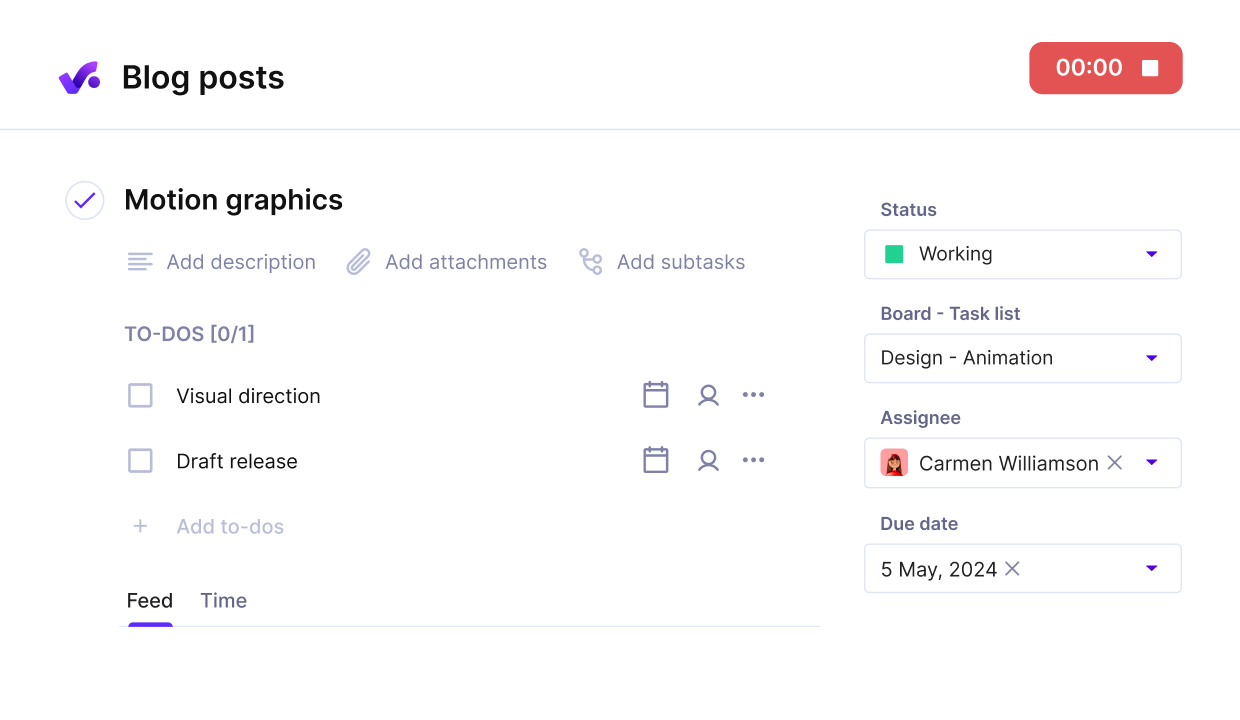
Leave comments, updates, attached files, and track time directly on tasks.
2. Feedback That’s Hard to Track
When reviews comes through Looms, spreadsheets, and meetings without being logged, it gets lost or ignored. That leads to missed changes, rework, and frustration on both sides.
How to fix it: Build structured feedback checkpoints into your workflow. Use tools that let you tag, resolve, and document client comments directly in the context of the task or deliverable.
3. Misaligned Expectations
You promised a weekly report. They expected a daily update. The kickoff felt clear, but three weeks in, everyone’s on a different page.
How to fix it: Align early and often. During onboarding, outline communication rhythms, delivery formats, and what clients should expect. Then reinforce that plan during every checkpoint.
4. Manual Reporting Overload
Teams spend hours pulling time logs, formatting slides, and chasing down numbers for weekly or monthly updates.
How to fix it: Automate reporting. Set up dashboards that update in real-time using your time tracking, budgeting, and task data. Clients get the transparency they want, and your team gets their time back.
5. Lack of Visibility Into Team Capacity
You say yes to a client request, but your team’s already overbooked. Deadlines get tight. Quality slips. Trust takes a hit. Unhappy clients churn and business revenue decreases.
How to fix it: Connect project planning with real capacity data. Before committing to timelines, check availability across your team, and make sure priorities are balanced.
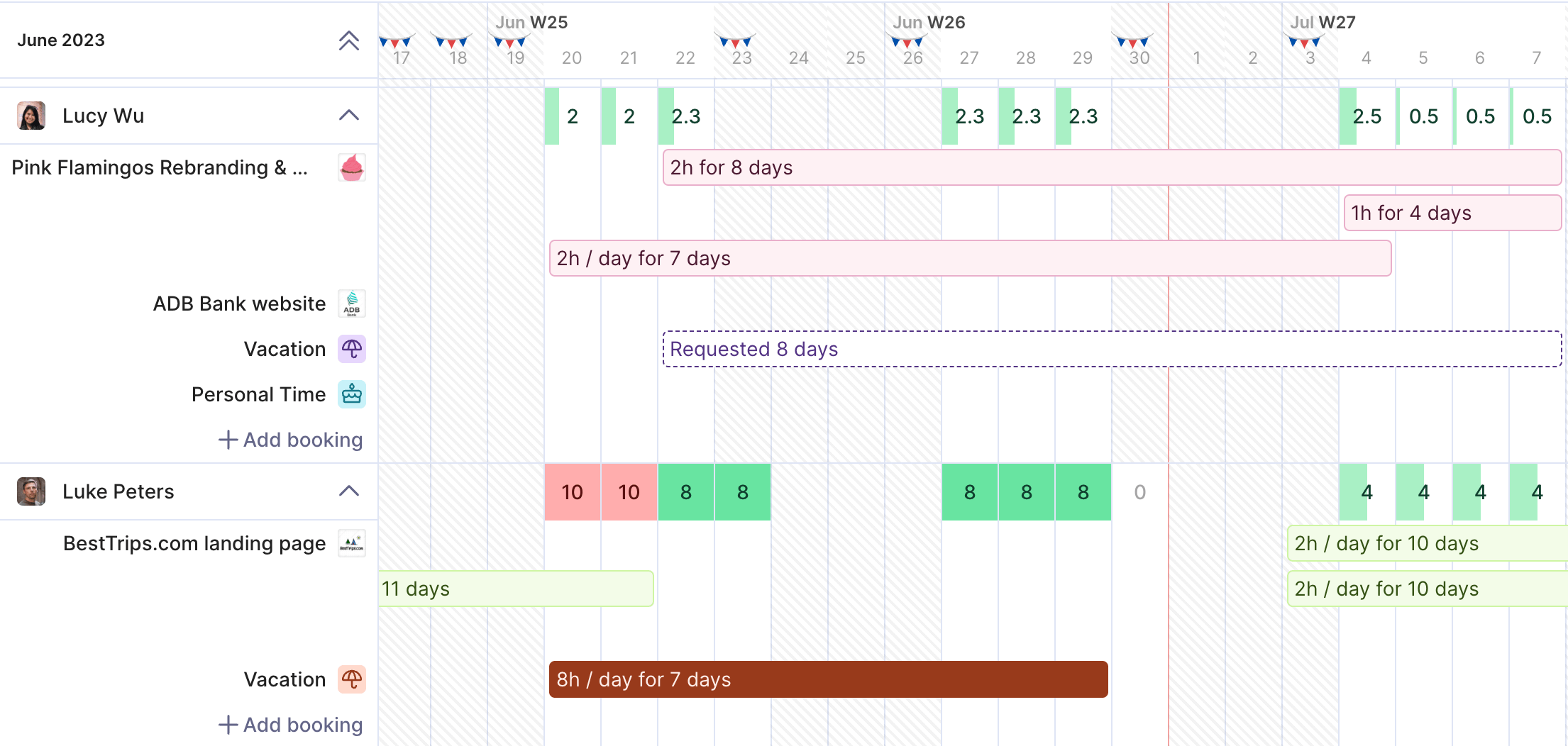
Use Productive to plan based on your actual team capacity.
How to Improve Client Management?
You can improve client management by focusing on three things: clarity, consistency, and scalability. This means documenting your processes, reducing manual work, and giving clients additional visibility without creating extra admin work for your team.
The idea here isn’t to add more new tools, but to simplify how you use them.
Let’s walk through some practical solutions that will improve how your team manages clients and customers.
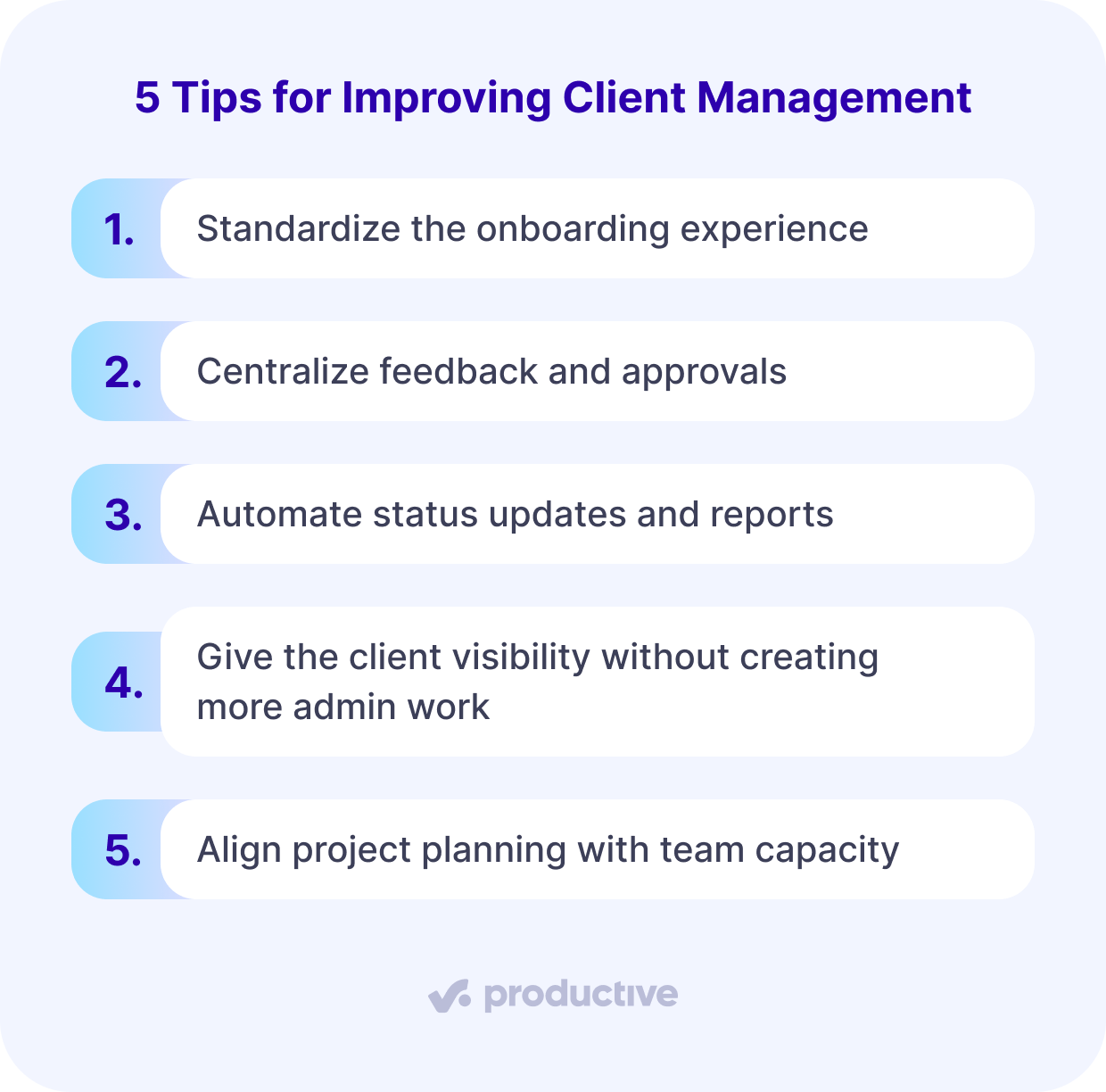
Standardize the Onboarding Experience
Strong onboarding sets the tone for every project. If your process feels inconsistent or unclear, clients will expect the same from the rest of the engagement.
What to include:
- Onboarding doc with a communication plan, used tools, task delivery frameworks, and execution timelines.
- Project goals and deliverables recap.
- Introductions to team members and responsibilities.
- Kickoff checklist that covers access, assets, and expectations.
Once documented, this process becomes repeatable and scalable across every new project and client.
Centralize Feedback and Approvals
If your team is digging through Slack threads and emails for client reviews, you’re on the wrong path. Untracked feedback leads to missed edits and client frustration, so you should nip this in the bud and keep all task-related feedback directly on the tasks.
What to do:
- Set up one place to collect and resolve client comments (e.g., task comments, shared docs, or approval queues).
- Assign one owner for tracking approvals on each project.
- Build review checkpoints into your project timeline to avoid bottlenecks.
Automate Status Updates and Business Reports
Clients want to know what’s going on, but that doesn’t mean your team should spend hours compiling slides. What you should do is stick to a reporting routine that can be automated (with human oversight).
How to simplify:
- Create live dashboards using data from your time tracking and task management.
- Set automated status reports that send weekly or biweekly.
- Include budget usage, time tracked, blockers, and what’s next.
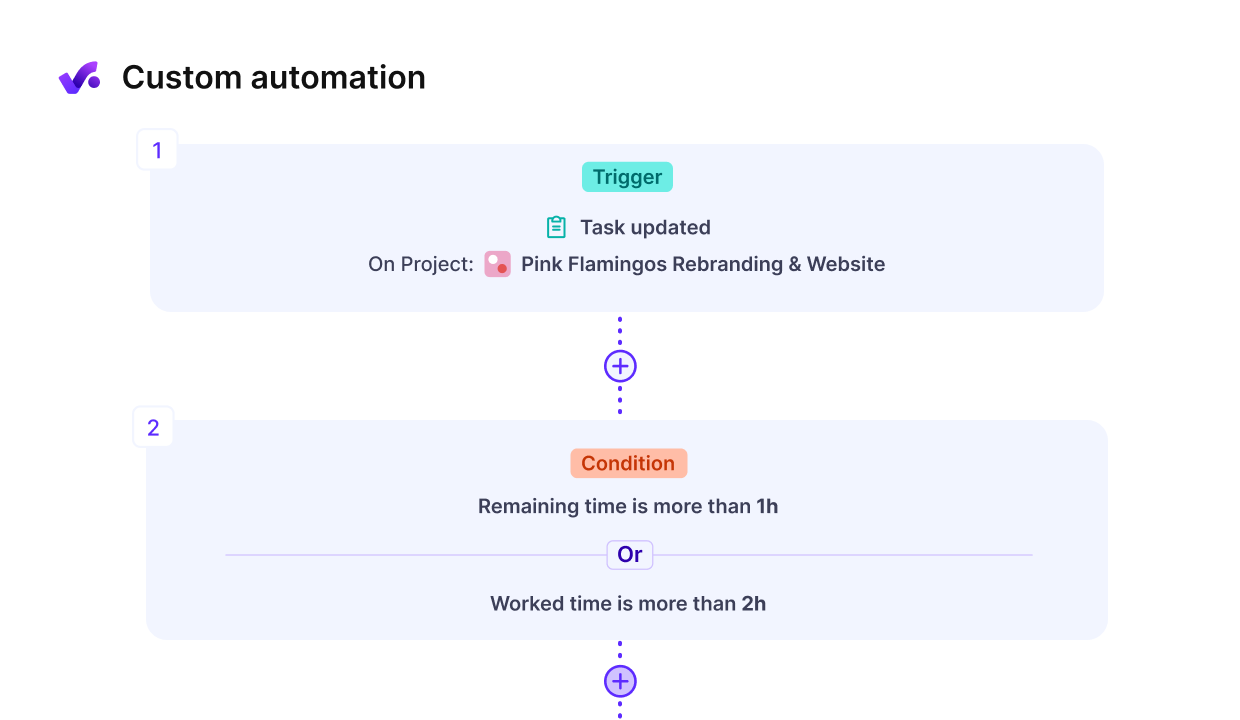
Automate routine work with Productive’s automations.
Give Your Client Visibility Without Creating More Admin Tasks
Clients should be able to check on progress, budget, and scope without asking. But that doesn’t mean you need to open up your entire system. Instead, you should invite them to the projects (as collaborators or guest users) you’re working on, especially when applying value-based client pricing that ties transparency to measurable outcomes.
Here’s how:
- Set up limited-access client dashboards with key info only.
- Use view-only reports that refresh automatically.
- Share notes and updates in one dedicated place – not across five tools.
Align Project Planning With Team Capacity
One of the biggest causes of missed deadlines is overpromising without knowing what your team can handle. This is actually a very common problem that happens due to poor internal communication and conflicting goals.
The scenario usually looks something like this:
A sales manager is pushing to increase revenue by bringing in additional client work. The project lead wants to deliver high-quality outcomes, but lacks the visibility or capacity data to push back or reassign resources effectively.
The good news is that you can easily fix it with:
- Resource planning tools that connect with your task system.
- Clear visibility into who’s available and for how long.
- Pre-set project templates that reflect your actual delivery model.
Client management becomes much easier when you set the right expectations from the start and have the systems to deliver on them.
In case you’re hard time with this planning part, you might want to head over to our guide on resource planning for multiple projects.
What Tools Make Managing Clients Easier in 2026?
The right tools for managing clients are project management software with client portals, client-facing collaboration tools, CRMs for sales and contact tracking, time tracking systems, and budgeting tools.
These platforms reduce admin work, centralize communication, and help teams and clients stay aligned throughout the entire project lifecycle. Before you start choosing your client-facing and project management toolkit, you should really consider the following sections of the article.
CRMs vs. All-in-One Project Management Platforms
CRMs are great for managing leads and sales pipelines, but they rarely help once a deal is closed. Agencies need tools that support delivery: timelines, budgets, reviews, and reporting.
All-in-one platforms combine project management, time tracking, resource planning, and client collaboration in one place. They make it easier to see what’s happening, who’s doing what, and how it’s impacting budget and timeline.
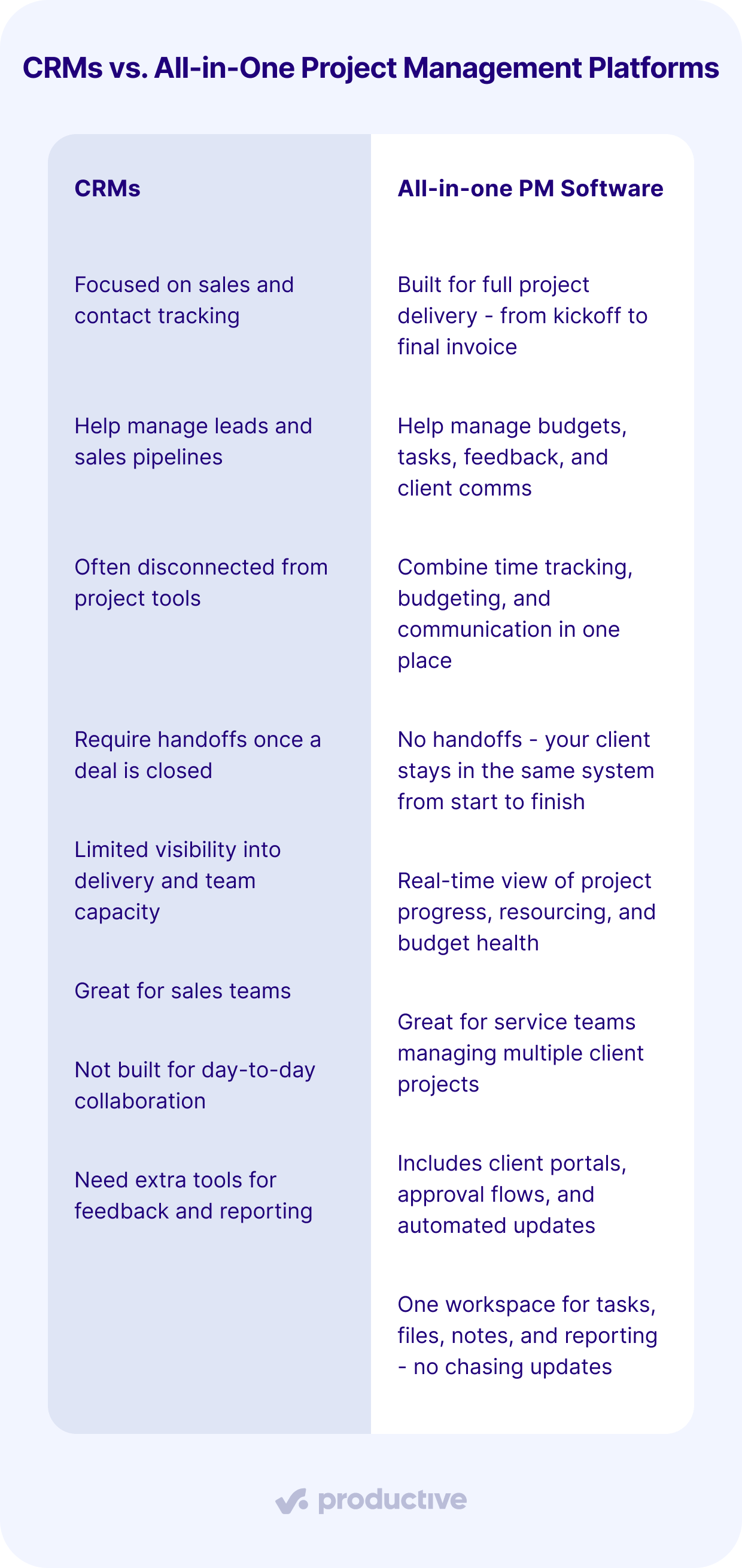
What to Look for in a Client-Facing Tool?
Not every platform is built with client-facing workflows in mind. The best tools for managing clients should offer:
- Centralized communication and updates (so you’re not chasing emails).
- Clear task and project views (so clients can check progress without pinging you).
- Integrated time and budget tracking (so you don’t need another spreadsheet, plus you get early warnings before budget overruns).
- Flexible client permissions and guest user access (so you control what they see).
In case you’re already thinking about options, you should head over to our big list of the best tools with a client-facing portal.
How to Choose What Works for Your Team?
Pick tools that fit your team’s workflow, not the other way around. If your team hates it, you’ll end up back in spreadsheets. Look for software that lets you:
- Standardize onboarding, delivery, and reporting.
- Automate reminders and recurring check-ins.
- Report on projects without copying data across tools.
The tools also needs to be visual, easy to use, and have an excellent support team (especially during onboarding).
The right platform simplifies your day-to-day, saves your team time, and makes your company easier to work with. For more actionable tips, and choosing advice check out our how to choose project management software guide.
Final Takeaway: Why Is a Client Management System a Competitive Advantage
A well made client management system a competitive edge because it directly impacts retention, reputation, and operational efficiency. When pricing and offerings look similar across providers, the way you communicate, collaborate, and deliver becomes the key differentiator.
Companies that consistently meet expectations, respond clearly, and make the client interactions feel easy are the ones that get rehired and referred.
Better client management leads to:
- Higher customer retention rates
- Smoother project delivery and higher customer success
- More business referrals and upsell opportunities
- Lower internal burnout from last-minute chaos
When you give clients transparency, reduce friction, and help them feel supported throughout the engagement, you’re building a long-term relationship.
Productive helps thousands of companies manage their projects, finances, and clients in one place, giving them the clarity and control needed to run a reliable, client-friendly operation.
Book a demo to see how Productive helps improve every part of the client experience.
Improve Client Management with Productive
Centralize tasks, updates, and client communication in one workspace – with zero extra admin. Give your team the visibility they need, and your clients the clarity they expect.
